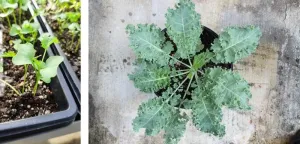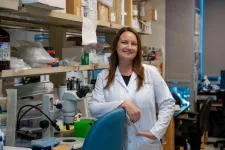(Press-News.org) SAN FRANCISCO, Aug. 15, 2023 — “Back-to-school” season means buying pens and paper, figuring out the new bus route, and … earaches. Doctors typically treat these infections with antibiotics, but children don’t always complete the full course, accelerating resistance to these medications. Today, researchers report developing a single-use nanoscale system that’s unlikely to generate resistance. Using a compound similar to bleach in test animals, they show it can kill off one type of bacterium that causes ear infections, and it could someday be easily applied as a gel.
The researchers will present their results today at the fall meeting of the American Chemical Society (ACS). ACS Fall 2023 is a hybrid meeting being held virtually and in-person Aug. 13–17, and features about 12,000 presentations on a wide range of science topics.
A video on the research is available at www.acs.org/Earaches.
“We initially conceived of this idea by looking at the household cleaner bleach. Even though it has been used since the 19th century, bacteria do not appear to have developed any widespread resistance to this cleaner,” says Rong Yang, Ph.D., the project’s principal investigator.
But Yang quickly warns that people should not treat infections with bleach. The solution sold at stores is highly concentrated and caustic, but when used in a properly controlled manner at extremely low concentrations, the active ingredient in bleach is considered compatible with living tissue.
After realizing that the active ingredient in the household cleaner could circumvent antibiotic resistance, the researchers, who are at Cornell University, decided to tackle a nearly universal childhood scourge: acute ear infections. These infections affect more than 95% of children in the U.S., and treatment typically requires taking antibiotics for five to 10 days. However, these regimens can cause problematic side effects, leading some families to discontinue the medication prematurely, particularly if symptoms resolve. But using these medications improperly can speed up the development of antibiotic resistance, which makes infections more difficult, if not impossible, to treat. This issue ranks among the biggest threats to global health, according to the World Health Organization.
Bacteria have more success fighting against some substances than others. Hypochloric acid from bleach belongs to a family of compounds, known as hypohalous acids, to which bacteria have yet to develop any significant resistance — most likely because of the numerous ways these highly reactive acids damage microbial cells, Yang says.
Because these substances break down quickly, Yang and her colleagues sought to generate one of them on an as-needed basis behind the eardrum in the middle ear, where ear infections occur. They found inspiration in an enzyme from giant kelp, which converts hydrogen peroxide (H2O2) to hypobromous acid (HOBr), a chemical relative of bleach.
A frequent cause of ear infections, the bacterium Streptococcus pneumoniae produces H2O2 to fight off other microbes. To mimic the kelp enzyme, which contains the metal vanadium, Yang and her colleagues designed nanowires made of vanadium pentoxide (V2O5). These produce HOBr only in the presence of the H2O2-producing bacteria, and their rod-like shape helps to keep them in place by reducing their ability to diffuse into body fluids.
In tests on chinchillas, which contract ear infections from the same pathogens as human children, they succeeded in eliminating most of the S. pneumoniae. Yang and colleagues found that after treatment with the nanowires, the animals’ once-inflamed eardrums returned to normal. Meanwhile, tests in healthy animals found evidence that the treatment did not interfere with hearing.
For these experiments, the researchers injected the nanowires directly into the middle ear. In more recent work in chinchillas, they developed a less invasive, more practical method for delivering the wires. By decorating the nanowires with peptides known to transport small particles across the eardrum, Yang and her team found they could deliver the treatment topically as a gel deposited into the ear canal. Once the gel was applied, the nanowires within it went through the intact tissue. They are also exploring other approaches for passing the nanowires through the eardrum.
Because other ear-infection-causing bacteria do not produce H2O2, the researchers are currently examining whether this system is effective in the presence of microbes other than S. pneumoniae, and how they might adapt it to fight the other bugs.
The researchers have not yet done studies to determine how long the system stays in place, although their evidence suggests the nanowires drain out of the middle ear after the infection clears. However, Yang suspects they could adapt the nanowires’ properties to stay in place for long periods afterward. This latter approach could make it possible to prevent recurrent infections that plague many children.
“If the bacteria return, the system could restart, so children wouldn't need antibiotics repeatedly and breed more resistance along the way,” Yang says.
The researchers acknowledge support and funding from the National Institute on Deafness and Other Communication Disorders.
A recorded media briefing on this topic will be posted Tuesday, Aug. 15, by 10 a.m. Eastern time at www.acs.org/acsfall2023briefings. Reporters can request access to media briefings during the embargo period by contacting newsroom@acs.org.
For health and safety information for ACS Fall 2023, please visit the FAQ webpage.
The American Chemical Society (ACS) is a nonprofit organization chartered by the U.S. Congress. ACS’ mission is to advance the broader chemistry enterprise and its practitioners for the benefit of Earth and all its people. The Society is a global leader in promoting excellence in science education and providing access to chemistry-related information and research through its multiple research solutions, peer-reviewed journals, scientific conferences, eBooks and weekly news periodical Chemical & Engineering News. ACS journals are among the most cited, most trusted and most read within the scientific literature; however, ACS itself does not conduct chemical research. As a leader in scientific information solutions, its CAS division partners with global innovators to accelerate breakthroughs by curating, connecting and analyzing the world’s scientific knowledge. ACS’ main offices are in Washington, D.C., and Columbus, Ohio.
To automatically receive press releases from the American Chemical Society, contact newsroom@acs.org.
Note to journalists: Please report that this research was presented at a meeting of the American Chemical Society.
Follow us: Twitter | Facebook | LinkedIn | Instagram
Title
Eradication of ear infection via autonomous synthesis of antimicrobials
Abstract
Otitis media (OM) is the main reason for pediatric antibiotic prescriptions. The current treatment mandates a rigorous regimen of multidose antibiotics over 5–10 days. The systemic antibiotic exposure and often prematurely terminated treatment due to the challenge of drug administration to young patients are believed to breed antibiotic resistance. To address these challenges, we designed a local treatment that converted a metabolic product (H2O2) of an OM pathogen (Streptococcus pneumoniae) into a potent antiseptic (HOBr), a reaction catalyzed by locally administered nanozymes, i.e., vanadium pentoxide nanowires. The therapeutic, HOBr, was only synthesized in the presence of the pathogen, enabling on-demand and targeted generation of therapeutics for OM treatment. Hypohalous acids are broad-spectrum and have a long history in general disinfection applications without breeding substantial drug resistance. A single dose of the nanowire formulation eradicated OM in a standard chinchilla model in 7 days with no observable tissue toxicity or negative impact on hearing sensitivity.
END
Treating back-to-school ear infections without antibiotic resistance (video)
2023-08-15
ELSE PRESS RELEASES FROM THIS DATE:
Discarded aloe peels could be a sustainable, natural insecticide (video)
2023-08-15
SAN FRANCISCO, Aug. 15, 2023 — Aloe barbadensis, commonly known as aloe vera, has been used for thousands of years to treat skin ailments, promote digestive health and heal wounds. But while aloe vera gel is in high demand, the peels are thrown away as agricultural waste. Today, scientists report that these peels, or rinds, can ward off bugs, acting as a natural insecticide. They have identified several bioactive compounds in extracts from the peels that deter insects from feasting on crops.
The researchers will present their results at the fall meeting of the American Chemical Society (ACS). ACS Fall ...
Microgreens and mature veggies differ in nutrients, but both might limit weight gain
2023-08-15
SAN FRANCISCO, Aug. 15, 2023 — Young vegetables known as microgreens are reputed to be particularly good for health. Now, researchers are trying to find out if microgreens — which can easily be grown at home — are the superfood they’re claimed to be, and how they compare to mature veggies. Results to date show their nutritional profiles differ, as do their effects on gut bacteria. Yet, tests in mice suggest that both microgreen and mature vegetables can limit weight gain.
The researchers will present their results today at the fall meeting ...
Detecting risk of metastatic prostate cancer in Black men
2023-08-15
SAN FRANCISCO, Aug. 15, 2023 — To explore why prostate cancer disproportionately sickens and kills Black men, researchers are looking to another disorder, diabetes, which alters metabolism. They used this approach in a preliminary clinical trial and today report the identification of four metabolism-related biomarkers linked to an increased risk of metastatic prostate cancer in men of West African heritage. This discovery could lead to improved testing and treatments for these patients.
The researchers will present their results at the fall ...
City of Hope researchers identify biomarkers that may detect risk of advance prostate cancer in Black men
2023-08-15
LOS ANGELES — Scientists at City of Hope, one of the largest cancer research and treatment organizations in the United States and a leading research center for diabetes and other life-threatening illnesses, have identified a cell metabolism process found in men with diabetes and metastatic prostate cancer that could one day lead to improved testing and treatments for Black men with these diseases. The research will be highlighted in the press program for the American Chemical Society (ACS) Fall 2023, a hybrid meeting that ...
Scientists pinpoint the microbes essential to making traditional mozzarella
2023-08-15
Mozzarella is far more than just a pizza topping. A unique Italian cheese, buffalo mozzarella from Campania has been recognized as a delicacy and protected under EU law for nearly 30 years. But what makes this mozzarella so special? The ingredients are simple: water buffalo milk, rennet, and natural whey starter, processed using fresh water and brine. But the natural whey starter contains microbes that are crucial to developing the mozzarella. Scientists from Italy used high-throughput 16S rRNA amplicon ...
Teachers perceive more conflict with Black boys, closer relationships with white girls
2023-08-15
A team of researchers led by a Virginia Commonwealth University professor found that teachers, regardless of race, perceived the most conflict with Black boys and the least conflict with white girls in their classrooms. Teachers also perceived their relationships with Black boys as increasing in conflict at higher rates than with white and female children across kindergarten through second grade, according to findings published this summer in the Journal of School Psychology.
The study analyzed nationally representative survey data from 9,190 participants – teachers who evaluated relationships ...
Novel biologic Ab-IPL-IL-17™ shows promise for rheumatoid arthritis and inflammatory bowel disease
2023-08-15
Researchers have shown that a novel antibody generated to target an 'essential amino acid sequence’ of both interleukin-17A and F has greater activity and potentially fewer side effects than existing biological therapies for conditions such as as rheumatoid arthritis (RA), psoriasis, and inflammatory bowel disease (IBD).
The antibody, called Ab-IPL-IL-17™, targets a specific section of signalling proteins IL-17A and IL-17F which play a central role in sustaining inflammation during onset and ...
Scientists explore dinosaur ‘coliseum’ in Denali National Park
2023-08-15
University of Alaska Fairbanks scientists have discovered and documented the largest known single dinosaur track site in Alaska. The site, located in Denali National Park and Preserve, has been dubbed “The Coliseum” by researchers.
The Coliseum is the size of one-and-a-half football fields and contains layer upon layer of prints preserved in rock. The site is a record of multiple species of dinosaurs over many generations that thrived in what is now Interior Alaska nearly 70 million years ago. The scientists describe the site in a paper recently published ...
Dogs can detect COVID-19 infections faster and more accurately than conventional technology, demonstrating readiness for mainstream medical applications
2023-08-15
It’s an idea that has finally gained scientific consensus: Dogs can be a faster, more precise, less expensive — not to mention friendlier — method of detecting COVID-19 than even our best current technology. A growing number of studies over the last two or so years has highlighted the power of dogs in detecting the stealthy virus and its variants, even when they are obscured by other viruses, like those from common colds and flu.
“It went from four papers to 29 peer-reviewed studies — that includes more than 400 scientists from over 30 countries and 31,000 samples,” said UC Santa Barbara Distinguished Professor Emeritus Tommy Dickey, who with ...
Images of enzyme in action reveal secrets of antibiotic-resistant bacteria
2023-08-15
Bacteria draw from an arsenal of weapons to combat the drugs intended to kill them. Among the most prevalent of these weapons are ribosome-modifying enzymes. These enzymes are growing increasingly common, appearing worldwide in clinical samples in a range of drug-resistant bacteria.
Now scientists have captured the first images of one important class of these enzymes in action. The images show how the enzymes latch onto a particular site on the bacterial ribosome and squeeze it like a pair of tweezers to extract an RNA nucleotide and alter it. The Proceedings of the National Academy of Sciences (PNAS) published the findings, led by scientists at Emory University.
The advanced technique ...



